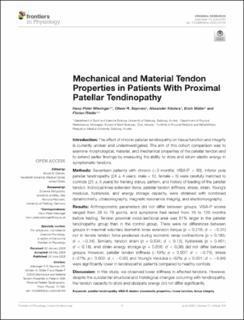| dc.description.abstract | Introduction: The effect of chronic patellar tendinopathy on tissue function and integrity is currently unclear and underinvestigated. The aim of this cohort comparison was to examine morphological, material, and mechanical properties of the patellar tendon and to extend earlier findings by measuring the ability to store and return elastic energy in symptomatic tendons.
Methods: Seventeen patients with chronic (>3 months, VISA-P < 80), inferior pole patellar tendinopathy (24 ± 4 years; male = 12, female = 5) were carefully matched to controls (25 ± 3 years) for training status, pattern, and history of loading of the patellar tendon. Individual knee extension force, patellar tendon stiffness, stress, strain, Young’s modulus, hysteresis, and energy storage capacity, were obtained with combined dynamometry, ultrasonography, magnetic resonance imaging, and electromyography.
Results: Anthropometric parameters did not differ between groups. VISA-P scores ranged from 28 to 78 points, and symptoms had lasted from 10 to 120 months before testing. Tendon proximal cross-sectional area was 61% larger in the patellar tendinopathy group than in the control group. There were no differences between groups in maximal voluntary isometric knee extension torque (p = 0.216; d < −0.31) nor in tensile tendon force produced during isometric ramp contractions (p = 0.185; d < −0.34). Similarly, tendon strain (p = 0.634; d < 0.12), hysteresis (p = 0.461; d < 0.18), and strain energy storage (p = 0.656; d < 0.36) did not differ between groups. However, patellar tendon stiffness (−19%; p = 0.007; d < −0.74), stress (−27%; p< 0.002; d < −0.90) and Young’s modulus (−32%; p = 0.001; d < −0.94) were significantly lower in tendinopathic patients compared to healthy controls.
Discussion: In this study, we observed lower stiffness in affected tendons. However, despite the substantial structural and histological changes occurring with tendinopathy, the tendon capacity to store and dissipate energy did not differ significantly. | en_US |
